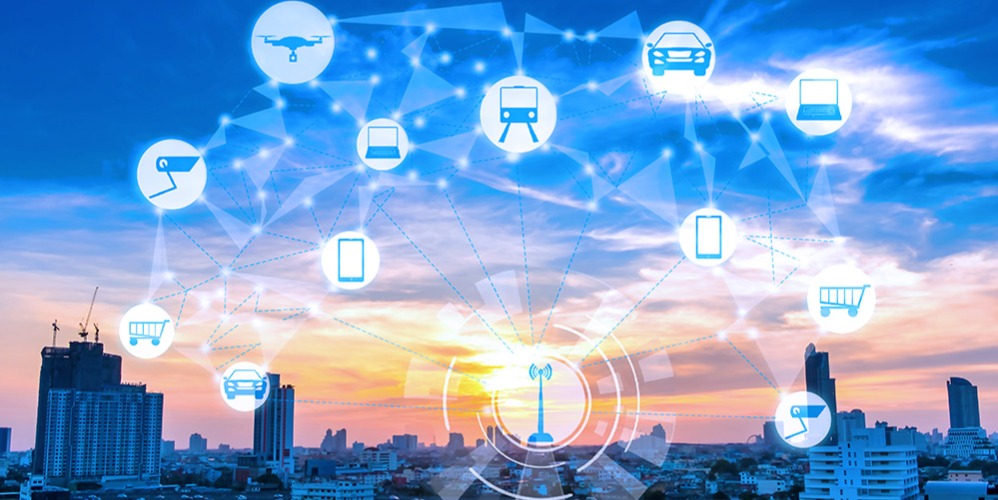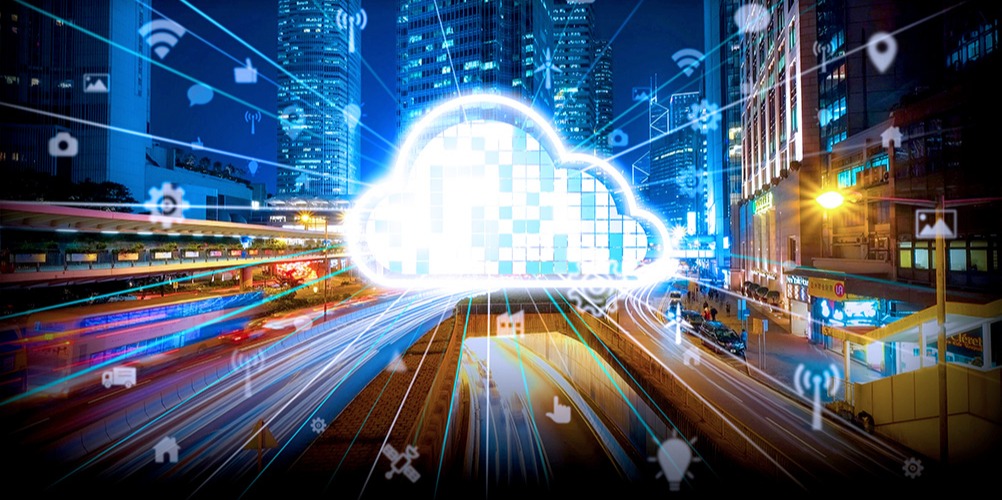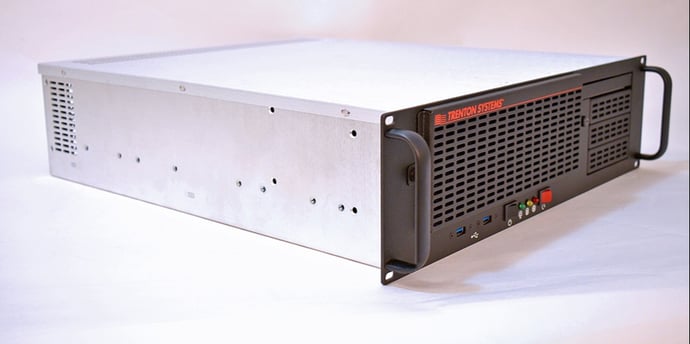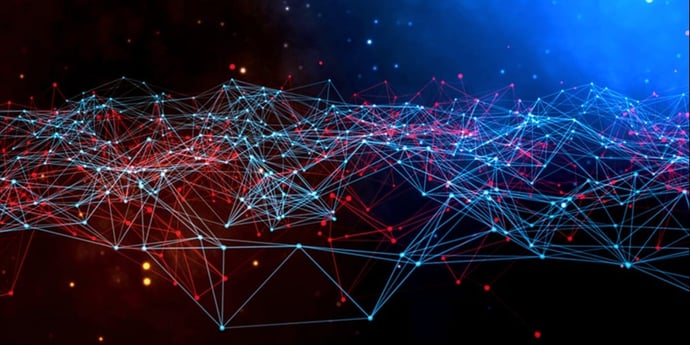Share this
Edge Computing vs. Fog Computing: Is There a Real Difference?
by Brett Daniel on Oct 21, 2024 2:11:29 PM
Graphic: Edge computing is here to stay. Are you prepared for the changes it will bring?
Table of Contents
- Background: the Internet of Things (IoT) & cloud computing are driving the edge
- The benefits of edge computing/fog computing
- Edge computing vs. fog computing: Is there an actual difference?
- Equipping your program or application with a reliable edge/fog server
Businesses and organizations are generating more raw data than ever before - so much, in fact, that sending it to the cloud for processing and storage has become a costly and inefficient endeavor.
The more data they send to the cloud for analysis and storage, the more money they spend on transferring said data. This newfound surge in throughput also creates a rise in latency, which translates to a delay in response times for a given business’s or organization’s human and physical capital - that is, the employees and autonomous machines using the insights derived from the raw data to do real work and make real decisions.
When businesses and organizations need to elicit insights from this raw data nearly instantaneously to remain competitive in an ever-technologically-demanding global market, such an inefficient architecture can become a cumbersome responsibility that wastes both time and money.
And you know the old saying: time is money.
Enter edge computing/fog computing.
In this blog post, we'll provide a brief background on how the Internet of Things (IoT) and cloud computing are driving edge computing/fog computing, discuss the benefits of edge computing/fog computing, and talk about whether there's an actual difference between the two. Stick around.

Graphic: The Internet of Things (IoT) and inefficiencies in cloud computing are driving the adoption of edge/fog computing during the Fourth Industrial Revolution.
Background: the Internet of Things (IoT) & cloud computing are driving the edge
The advent of the Internet of Things (IoT) is responsible for businesses’ and organizations’ newfound influx of raw data.
Basically, devices and machines that we’ve used for decades are becoming increasingly equipped with sensors that collect nearby data and push it to cloud data centers, which then crunch this data to return insights that we, the users, can use for learning, research, and decision-making.
Smartwatches are probably the most relatable example. Smartwatches use sensors to measure and collect data about your body – your temperature and your heart rate, for example – but this is just raw data. It must be computed to give you the insight you desire, and this wouldn’t be possible without sending it to the cloud for analysis.
On a much larger scale than mere smartwatches, these sensors have also found their place in or on military and industrial facilities and equipment - tanks, weapon systems, surveillance systems, manufacturing apparatuses, and others – where their sole purpose is to collect and transmit data about the environment.
The type of data gathered by an IoT sensor varies by sensor type. These sensor types include:
- Temperature sensors
- Humidity sensors
- Chemical sensors
- Acceleration sensors
- Velocity sensors
- Proximity sensors
- Water quality sensors
- Infrared sensors
- Light sensors
- Smoke sensors
- Gas sensors
And that’s not even the end of the list.
That’s a lot of data about a lot of different phenomena. In a particularly large business or organization employing lots of these sensors, how could all the data it collects possibly be transmitted to a cloud data center for analysis without a significant increase in data transfer costs and a delay in response times?
The short answer is that it can’t be, and that’s why edge computing, also known as fog computing, is becoming an increasingly popular choice for businesses and organizations that need not only a cost-effective but virtually real-time computing solution.

Graphic: The edge and the cloud have an important symbiotic relationship.
The benefits of edge computing/fog computing
IoT sensors collect raw data only. This data needs to be crunched into something usable for the end user, whether that’s an employee or a fully autonomous machine, and it needs to be crunched quickly so that businesses and organizations can remain competitive amid the ongoing Fourth Industrial Revolution.
Cloud data centers can crunch this data, of course, and they're a reliable solution for businesses and organizations with lower-volume networks, but as we’ve previously discussed, the cloud alone has become an inefficient computing paradigm for many multiplex business and organizational processes with an absolute necessity for nearly instantaneous response times.
Enter edge computing, also known as fog computing.
Establishing an edge computing architecture involves locating servers, commonly referred to as edge servers, closer to the data-generating IoT sensors that we discussed earlier.
These local servers are running the applications that crunch this data and provide user-oriented insights. In turn, less data travels to the cloud, and businesses and organizations save money on data transfer and improve response times.
And although some of this processed data can be stored at the edge, much of it is being sent back to the cloud for permanent storage, but remember, this is being done after the raw data has been processed by edge servers.
So, you’re effectively sending only important data back to the cloud instead of an endless stream of raw data, which costs more money to transfer and creates a rise in latency.
Think of edge computing as cloud computing’s helpful, fat-trimming aide in the field, pre-processing all that data and making it nice and tidy before it delivers it to the cloud.
-1.png?width=1000&name=Copy%20of%20Copy%20of%20MIL-STD-810G%20(1)-1.png)
Graphic: Edge computing and fog computing may seem like different architectures, but the truth isn't so clear.
Edge computing vs. fog computing: Is there an actual difference?
Whether there’s a difference between edge computing and fog computing depends on who you ask. Some say there are legitimate technical differences between the two, while others say the differences are purely semantic.
For example, it has been posited by Cisco, which coined the term "fog computing" in 2014, that "edge computing" merely refers to the concept of moving computational resources to or closer to data-generating devices, while "fog computing" refers to the literal implementation and management of this architecture at the edge of the cloud, a process known as "fogging."
Cisco has also categorized fog computing as just a type of edge computing technology.
To make matters even more convoluted, some industry blogs have posited that edge computing refers only to computation that occurs directly on smart devices, whereas with fog computing, the computation occurs within fog nodes or IoT gateways located in a business’s or organization’s local area network (LAN).
Here at Trenton Systems, when we use the term edge computing, we mean both. Our definition of edge computing is any data processing that’s done on, in, at, or near the source of data generation.
Scott Shadley, Vice President of Marketing at NGD Systems, a manufacturer of computational storage drives (CSDs), says that there really isn't a difference between edge computing and fog computing.
The fog was introduced by Cisco in 2014. It was the idea of 'cloud,’ then ‘fog,’ then ‘mist,’ as you came from the cloud to an edge to an endpoint. The term is still in use in some circles, but not as much as previously. For now, if you see 'fog,' you can simply say 'edge.'
Scott Shadley, Vice President of Marketing, NGD Systems
Like Shadley, many also maintain that there’s no real difference between edge computing and fog computing – that edge computing and fog computing are interchangeable terms and that they refer to the same type of distributed computing architecture.
What do you think? Let us know in the comments below.

Photo: Trenton Systems' high-performance edge servers have proven highly successful for real-time military, industrial, and commercial computing applications.
Equipping your program or application with a reliable edge/fog server
Whether you refer to the architecture as edge computing or fog computing, the need remains the same: process data as close to its source as possible to lower costs and achieve near-real-time response.
Incorporating trusted, high-performance rugged servers closer to your IoT smart devices can help you do both, no matter the conditions of the environment on land, in space, in air, or at sea.
Trenton Systems' talented engineers are on standby to help you design a rugged computing solution for your unique edge computing application.
Share this
- High-performance computers (42)
- Military computers (38)
- Rugged computers (32)
- Cybersecurity (25)
- Industrial computers (25)
- Military servers (24)
- MIL-SPEC (20)
- Rugged servers (19)
- Press Release (17)
- Industrial servers (16)
- MIL-STD-810 (16)
- 5G Technology (14)
- Intel (13)
- Rack mount servers (12)
- processing (12)
- Computer hardware (11)
- Edge computing (11)
- Rugged workstations (11)
- Made in USA (10)
- Partnerships (9)
- Rugged computing (9)
- Sales, Marketing, and Business Development (9)
- Trenton Systems (9)
- networking (9)
- Peripheral Component Interconnect Express (PCIe) (7)
- Encryption (6)
- Federal Information Processing Standards (FIPS) (6)
- GPUs (6)
- IPU (6)
- Joint All-Domain Command and Control (JADC2) (6)
- Server motherboards (6)
- artificial intelligence (6)
- Computer stress tests (5)
- Cross domain solutions (5)
- Mission-critical servers (5)
- Rugged mini PCs (5)
- AI (4)
- BIOS (4)
- CPU (4)
- Defense (4)
- Military primes (4)
- Mission-critical systems (4)
- Platform Firmware Resilience (PFR) (4)
- Rugged blade servers (4)
- containerization (4)
- data protection (4)
- virtualization (4)
- Counterfeit electronic parts (3)
- DO-160 (3)
- Edge servers (3)
- Firmware (3)
- HPC (3)
- Just a Bunch of Disks (JBOD) (3)
- Leadership (3)
- Navy (3)
- O-RAN (3)
- RAID (3)
- RAM (3)
- Revision control (3)
- Ruggedization (3)
- SATCOM (3)
- Storage servers (3)
- Supply chain (3)
- Tactical Advanced Computer (TAC) (3)
- Wide-temp computers (3)
- computers made in the USA (3)
- data transfer (3)
- deep learning (3)
- embedded computers (3)
- embedded systems (3)
- firmware security (3)
- machine learning (3)
- Automatic test equipment (ATE) (2)
- C6ISR (2)
- COTS (2)
- COVID-19 (2)
- CPUs (2)
- Compliance (2)
- Compute Express Link (CXL) (2)
- Computer networking (2)
- Controlled Unclassified Information (CUI) (2)
- DDR (2)
- DDR4 (2)
- DPU (2)
- Dual CPU motherboards (2)
- EW (2)
- I/O (2)
- Military standards (2)
- NVIDIA (2)
- NVMe SSDs (2)
- PCIe (2)
- PCIe 4.0 (2)
- PCIe 5.0 (2)
- RAN (2)
- SIGINT (2)
- SWaP-C (2)
- Software Guard Extensions (SGX) (2)
- Submarines (2)
- Supply chain security (2)
- TAA compliance (2)
- airborne (2)
- as9100d (2)
- chassis (2)
- data diode (2)
- end-to-end solution (2)
- hardware security (2)
- hardware virtualization (2)
- integrated combat system (2)
- manufacturing reps (2)
- memory (2)
- mission computers (2)
- private 5G (2)
- protection (2)
- secure by design (2)
- small form factor (2)
- software security (2)
- vRAN (2)
- zero trust (2)
- zero trust architecture (2)
- 3U BAM Server (1)
- 4G (1)
- 4U (1)
- 5G Frequencies (1)
- 5G Frequency Bands (1)
- AI/ML/DL (1)
- Access CDS (1)
- Aegis Combat System (1)
- Armed Forces (1)
- Asymmetric encryption (1)
- C-RAN (1)
- COMINT (1)
- Cloud-based CDS (1)
- Coast Guard (1)
- Compliance testing (1)
- Computer life cycle (1)
- Containers (1)
- D-RAN (1)
- DART (1)
- DDR5 (1)
- DMEA (1)
- Data Center Modular Hardware System (DC-MHS) (1)
- Data Plane Development Kit (DPDK) (1)
- Defense Advanced Research Projects (DARP) (1)
- ELINT (1)
- EMI (1)
- EO/IR (1)
- Electromagnetic Interference (1)
- Electronic Warfare (EW) (1)
- FIPS 140-2 (1)
- FIPS 140-3 (1)
- Field Programmable Gate Array (FPGA) (1)
- Ground Control Stations (GCS) (1)
- Hardware-based CDS (1)
- Hybrid CDS (1)
- IES.5G (1)
- ION Mini PC (1)
- IP Ratings (1)
- IPMI (1)
- Industrial Internet of Things (IIoT) (1)
- Industry news (1)
- Integrated Base Defense (IBD) (1)
- LAN ports (1)
- LTE (1)
- Life cycle management (1)
- Lockheed Martin (1)
- MIL-S-901 (1)
- MIL-STD-167-1 (1)
- MIL-STD-461 (1)
- MIL-STD-464 (1)
- MOSA (1)
- Multi-Access Edge Computing (1)
- NASA (1)
- NIC (1)
- NIC Card (1)
- NVMe (1)
- O-RAN compliant (1)
- Oil and Gas (1)
- Open Compute Project (OCP) (1)
- OpenRAN (1)
- P4 (1)
- PCIe card (1)
- PCIe lane (1)
- PCIe slot (1)
- Precision timestamping (1)
- Product life cycle (1)
- ROM (1)
- Raytheon (1)
- Remotely piloted aircraft (RPA) (1)
- Rugged computing glossary (1)
- SEDs (1)
- SIM Card (1)
- Secure boot (1)
- Sensor Open Systems Architecture (SOSA) (1)
- Small form-factor pluggable (SFP) (1)
- Smart Edge (1)
- Smart NIC (1)
- SmartNIC (1)
- Software-based CDS (1)
- Symmetric encryption (1)
- System hardening (1)
- System hardening best practices (1)
- TME (1)
- Tech Partners (1)
- Total Memory Encryption (TME) (1)
- Transfer CDS (1)
- USB ports (1)
- VMEbus International Trade Association (VITA) (1)
- Vertical Lift Consortium (VLC) (1)
- Virtual machines (1)
- What are embedded systems? (1)
- Wired access backhaul (1)
- Wireless access backhaul (1)
- accredidation (1)
- aerospace (1)
- air gaps (1)
- airborne computers (1)
- asteroid (1)
- authentication (1)
- autonomous (1)
- certification (1)
- cognitive software-defined radios (CDRS) (1)
- command and control (C2) (1)
- communications (1)
- cores (1)
- custom (1)
- customer service (1)
- customer support (1)
- data linking (1)
- data recording (1)
- ethernet (1)
- full disk encryption (1)
- hardware monitoring (1)
- heat sink (1)
- hypervisor (1)
- in-house technical support (1)
- input (1)
- integrated edge solution (1)
- international business (1)
- licensed spectrum (1)
- liquid cooling (1)
- mCOTS (1)
- microelectronics (1)
- missile defense (1)
- mixed criticality (1)
- moving (1)
- multi-factor authentication (1)
- network slicing (1)
- neural networks (1)
- new headquarters (1)
- next generation interceptor (1)
- non-volatile memory (1)
- operating system (1)
- output (1)
- outsourced technical support (1)
- post-boot (1)
- pre-boot (1)
- private networks (1)
- public networks (1)
- radio access network (RAN) (1)
- reconnaissance (1)
- rugged memory (1)
- secure flash (1)
- security (1)
- self-encrypting drives (SEDs) (1)
- sff (1)
- software (1)
- software-defined radios (SDRs) (1)
- speeds and feeds (1)
- standalone (1)
- storage (1)
- systems (1)
- tactical wide area networks (1)
- technical support (1)
- technology (1)
- third-party motherboards (1)
- troposcatter communication (1)
- unlicensed spectrum (1)
- volatile memory (1)
- vpx (1)
- zero trust network (1)
- January 2025 (1)
- November 2024 (1)
- October 2024 (1)
- August 2024 (1)
- July 2024 (1)
- May 2024 (1)
- April 2024 (3)
- February 2024 (1)
- November 2023 (1)
- October 2023 (1)
- July 2023 (1)
- June 2023 (3)
- May 2023 (7)
- April 2023 (5)
- March 2023 (7)
- December 2022 (2)
- November 2022 (6)
- October 2022 (7)
- September 2022 (8)
- August 2022 (3)
- July 2022 (4)
- June 2022 (13)
- May 2022 (10)
- April 2022 (4)
- March 2022 (11)
- February 2022 (4)
- January 2022 (4)
- December 2021 (1)
- November 2021 (4)
- September 2021 (2)
- August 2021 (1)
- July 2021 (2)
- June 2021 (3)
- May 2021 (4)
- April 2021 (3)
- March 2021 (3)
- February 2021 (8)
- January 2021 (4)
- December 2020 (5)
- November 2020 (5)
- October 2020 (4)
- September 2020 (4)
- August 2020 (6)
- July 2020 (9)
- June 2020 (11)
- May 2020 (13)
- April 2020 (8)
- February 2020 (1)
- January 2020 (1)
- October 2019 (1)
- August 2019 (2)
- July 2019 (2)
- March 2019 (1)
- January 2019 (2)
- December 2018 (1)
- November 2018 (2)
- October 2018 (5)
- September 2018 (3)
- July 2018 (1)
- April 2018 (2)
- March 2018 (1)
- February 2018 (9)
- January 2018 (27)
- December 2017 (1)
- November 2017 (2)
- October 2017 (3)
/Trenton%20Systems%20Circular%20Logo-3.png?width=50&height=50&name=Trenton%20Systems%20Circular%20Logo-3.png)


No Comments Yet
Let us know what you think